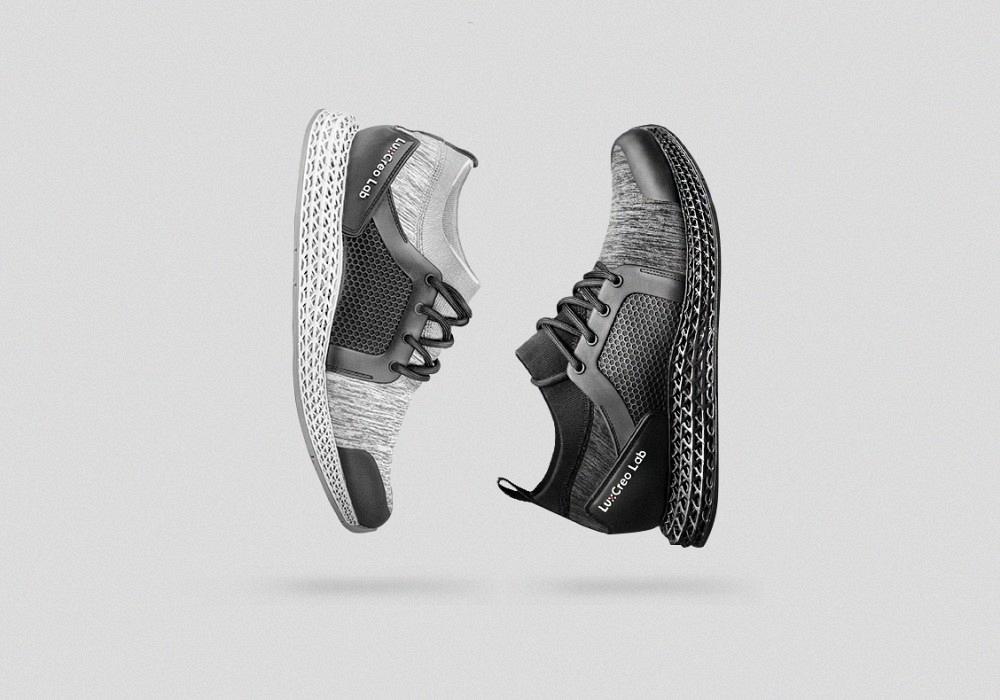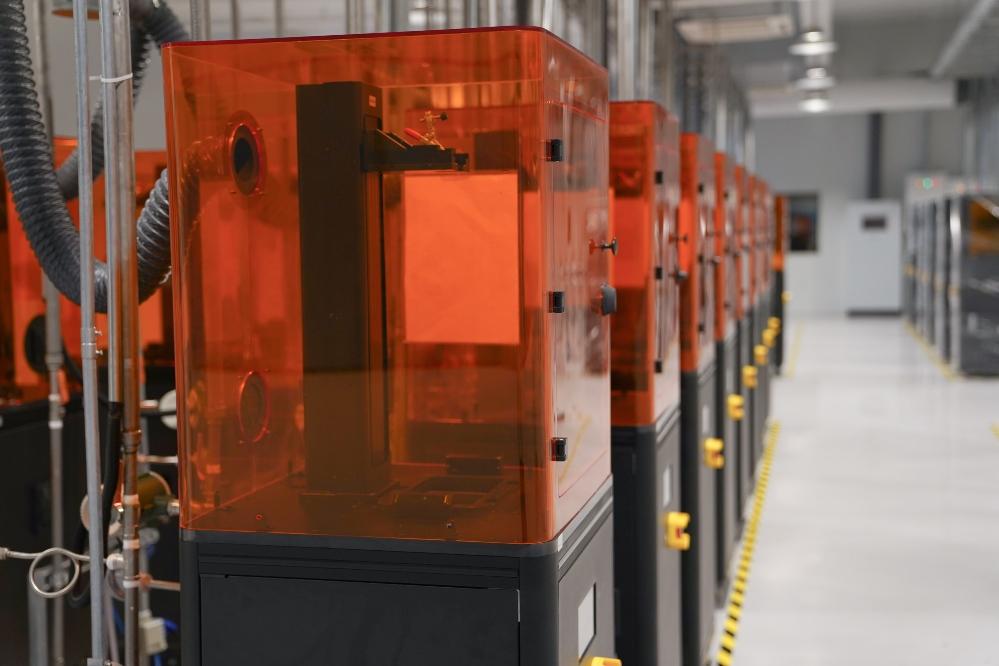- FMA
- The Fabricator
- FABTECH
- Canadian Metalworking
Our Publications
Categories
- Additive Manufacturing
- Aluminum Welding
- Arc Welding
- Assembly and Joining
- Automation and Robotics
- Bending and Forming
- Consumables
- Cutting and Weld Prep
- Electric Vehicles
- En Español
- Finishing
- Hydroforming
- Laser Cutting
- Laser Welding
- Machining
- Manufacturing Software
- Materials Handling
- Metals/Materials
- Oxyfuel Cutting
- Plasma Cutting
- Power Tools
- Punching and Other Holemaking
- Roll Forming
- Safety
- Sawing
- Shearing
- Shop Management
- Testing and Measuring
- Tube and Pipe Fabrication
- Tube and Pipe Production
- Waterjet Cutting
Industry Directory
Webcasts
Podcasts
FAB 40
Advertise
Subscribe
Account Login
Search
Additive manufacturer supplements its Smart Factory services with 3D printers
LuxCreo’s cloud-connected 3D printers allow customers to ‘instantly’ scale-up capacity
- By Holly B. Martin
- August 11, 2021
- Article
- Additive Manufacturing

Shoe manufacturers were among the earliest adopters of LuxCreo’s Smart Factory concept. Images: LuxCreo
Building upon the recent launches of its industrial-grade, cloud-connected DLP (digital light processing) and LCD 3D printers and high-performance resins, LuxCreo Inc. hopes to transform manufacturing. The firm, with locations in Belmont, Calif., and Beijing, seems well-situated to do that.
The COO and president of the North American office, Mike Yang, said LuxCreo was founded as a “production-first” company with the stated mission of “accelerating the world’s transition to sustainable manufacturing with 3D printing.”
“We started off in 2016 as an R&D company, demonstrating the ultralow adhesion force and fast printing speed of our nanotech LEAP [light enabled additive production] technology,” explained Yang. “One of the biggest challenges with bottom-up DLP additive manufacturing is that resins stick to both the build platform and the film when solidifying as a layer, limiting the printing speed and quality.”
To overcome this problem, some companies use techniques like creating a dead zone or using lower-adhesion-force films that allow the layer-by-layer DLP printing process to occur, Yang said. But LEAP technology leverages a nanostructure that reduces the film adhesion force so the layers don’t stick to the tank, similar to how a nonstick pan works. The lower adhesion, combined with heat, enables printing of many resins—such as high-viscosity elastomers, tough resins, and certain dental materials—that couldn’t be used before.
“We have the highest-performance elastic resins for sportswear, medical, and industrial applications, which many standard printers cannot effectively print,” Yang said.
Focus on Production
Once LuxCreo solved the adhesion problem, it began building its line of LEAP-based DLP and LCD printers. Instead of selling the printers, however, the company first launched a highly digitized, automated 3D printing Smart Factory in China. The parts-production service department worked with a number of well-known consumer brands.
“It was the fastest way to get our partners to market, improve our technology offering, and help them learn how to go into production with us,” said LuxCreo’s chief revenue officer, Michael Strohecker.
Being a production-first 3D printing solution provider distinguishes LuxCreo from most 3D printing companies, said Strohecker. Additive manufacturing service providers typically begin as a prototyping shops then scale up to production with, at best, “limited success.”
According to Strohecker, production-first means that every engagement—from day one—is focused on successful volume production. “The technologies that we’ve developed and the synergy between them enable a true end-to-end production workflow,” he said.
For LuxCreo, that workflow means complete vertical integration: the resins for each application, the software that slices the CAD model and defines the printing parameters, the cloud-connected printers, and postprocessing.
Secure Connection
In keeping with its production-first vision, LuxCreo developed its Smart Factory concept to prevent the disconnect that occurs when a manufacturer perfects a new design on a single 3D printer in a lab, then struggles to scale up to production volume.
“You have two options: You can buy more printers, which means a heavy capital investment,” said Strohecker, or, alternatively, “you can go to a service bureau and hope they have the materials and printers that work with your design.”
To remedy this disconnect, LuxCreo pioneered the cloud-connected 3D printer. “Once you prove and validate a print design using our resins, software, and one of our cloud-connected 3D printers, you can place an order with our cloud-connected Smart Factory—replicating your success and instantly scaling with our capacity,” Strohecker said.
LuxCreo developed its first Smart Factory partnerships while working with major shoe manufacturers. In the footwear industry, tooling costs are a major concern, especially when producing shoes in low to medium volumes.
There’s extensive tooling for every new model—from size 6 to size 15, with half-size increments, explained Strohecker. “When you can eliminate tooling, you don’t have to do minimum-order quantities of a single design, and that’s where additive manufacturing can transform production.”
The next market the company tackled was dental appliances. Making these devices has traditionally been a long process involving many manual steps and a lot of skilled labor. The typical approach when producing teeth aligners, retainers, and other dental appliances is to create an intermediate tool—a dental model—and then thermoform the final appliance.
Instead of thermoforming followed by an additional 15 or 20 minutes of cutting, grinding, buffing, and polishing, with LuxCreo’s dental solution “you just print, remove the support structures, buff for less than one minute, and it is ready for use,” Strohecker said. “Direct printing can reduce the labor cost and material by 90 percent.”
After a couple years of using industrial 3D printers of its own design to build production parts for customers at its California lab and factory in China, the company felt ready to launch a commercial version of its industrial machine, Lux, at the Formnext 2020 additive manufacturing show. (Note: The show was virtual because of COVID-19.) Then, at the Additive Manufacturing Users Group Conference this past May, the company launched its iLux desktop printers.
“We waited until we could provide a product that leads the market and is production-grade,” said Strohecker. “Both our desktop and industrial printers are designed to operate 24-7 and use our resins.”
Factory Sale
The next phase of the LuxCreo business plan is to sell its Smart Factory as a product.

The industrial DLP-style 3D printer LuxCreo originally developed for its Smart Factory is now commercially available.
“Building our production-first solutions, we started with our Smart Factory service. Then we began offering our cloud-connected printers where customers could control innovation, and scale up through our cloud-connected Smart Factory to achieve initial scale and market success,” Strohecker said.
The latest development is that the company now offers its Smart Factory to contract manufacturers. This allows 3D printing to be performed where assembly is happening, anywhere in the world, said Strohecker. “So instead of just selling 3D printers, we will be selling an entire solution for turnkey production.”
And that seems like a pretty smart way to go.
About the Author

Holly B. Martin
About the Publication
- Podcasting
- Podcast:
- The Fabricator Podcast
- Published:
- 04/16/2024
- Running Time:
- 63:29
In this episode of The Fabricator Podcast, Caleb Chamberlain, co-founder and CEO of OSH Cut, discusses his company’s...
- Trending Articles
- Industry Events
16th Annual Safety Conference
- April 30 - May 1, 2024
- Elgin,
Pipe and Tube Conference
- May 21 - 22, 2024
- Omaha, NE
World-Class Roll Forming Workshop
- June 5 - 6, 2024
- Louisville, KY
Advanced Laser Application Workshop
- June 25 - 27, 2024
- Novi, MI




























